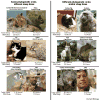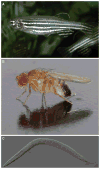Unearthing the phylogenetic roots of sleep
- PMID: 18682212
- PMCID: PMC2899675
- DOI: 10.1016/j.cub.2008.06.033
Unearthing the phylogenetic roots of sleep
Abstract
Why we sleep remains one of the enduring unanswered questions in biology. At its core, sleep can be defined behaviorally as a homeostatically regulated state of reduced movement and sensory responsiveness. The cornerstone of sleep studies in terrestrial mammals, including humans, has been the measurement of coordinated changes in brain activity during sleep measured using the electroencephalogram (EEG). Yet among a diverse set of animals, these EEG sleep traits can vary widely and, in some cases, are absent, raising questions as to whether they define a universal, or even essential, feature of sleep. Over the past decade, behaviorally defined sleep-like states have been identified in a series of genetic model organisms, including fish, flies and worms. Genetic analyses in these systems are revealing a remarkable conservation in the underlying mechanisms controlling sleep behavior. Taken together, these studies suggest an ancient origin for sleep and raise the possibility that model organism genetics may reveal the molecular mechanisms that guide sleep and wake.
Figures



References
-
- Campbell SS, Tobler I. Animal sleep: a review of sleep duration across phylogeny. Neurosci Biobehav Rev. 1984;8:269–300. - PubMed
-
- Rechtschaffen A, Gilliland MA, Bergmann BM, Winter JB. Physiological correlates of prolonged sleep deprivation in rats. Science. 1983;221:182–184. - PubMed
-
- Shaw PJ, Tononi G, Greenspan RJ, Robinson DF. Stress response genes protect against lethal effects of sleep deprivation in Drosophila. Nature. 2002;417:287–291. - PubMed
Publication types
MeSH terms
Grants and funding
LinkOut - more resources
Full Text Sources
Miscellaneous

